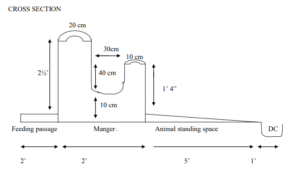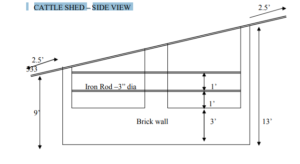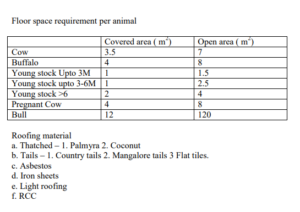GOOD MANAGEMENTAL PRACTICES TIPS FOR CATTLE
Care and Management of Pregnant, Lactating Animals and Work Bullocks.
- Care, management of Pregnant animals
- Identify pregnant-afterA.I.-90 days
2. Provide gentle treatment
3. First quarter of gestation period are critical
4. In early stages of pregnancy disturbances can cause abortion.
5. Provide concentrate feed 3.5 kg per day.
6. Provide 25 – 35 Kg. Greed fodder per day and 5 Kg. Paddy straw.
7. Minimum 45 – 60 days of dry period is essential.
8. Avoid long distance travel.
9. Avoid slippery condition in the shed.
10.Avoid chasing by dogs, bulls or children.
11.Avoid infighting between pregnant animals.
12.Separate pregnant animals from recently aborted animals or carriers of diseases like
brucellosis.
13.Provide adequate clean drinking water
14.Protect against extremes of climate. - Care and Management: Lactating animals.
- Protection against inclement weather.
2. Housing – Discussed earlier – space requirement.
3. Hygiene and sanitation of cattle shed and animals grooming, washing, disinfection etc.
4. Feeding a) concentrate – DM, DCP TDN b) Roughages – GF – L, NL – DF Thumb Rule : 450 –500 g Concentrate / Kg. milk production
DCP 15% : TDN 75% : M.33% GNC : 25% Wheat Bran : 40% Mineral Mixture : 1% Salt :
1%Green Fodder – 1/3 L : 2/3 NL
5. Peak yield – 6 week – ‘ca’ definition 1-1-1.3/1.18 g ca : 1.1/1.0 g ‘p’
Supplemented : Lime coat manger : ca i/v injection
6. Breeding – 60 days after calving does not come to heat – check with veterinary Doctor.
7. Artificial Insemination – Pregnancy verification – 90 days conception delayed – 2 A.I : check – 13-14 month calf.
8. Pregnant – 45 – 60 days period.
9. Drying – withdraw concentrate : feed dry fodder : milking alternate M/E –4 days.
10. Periodical vaccination RP, Bq, Hs, Anthrax Once in a year. Foot and mouth – once – 4 months.
11. Isolation of pregnant animal Gilmore (1952) reproductive efficiency
RE = 12 x No.of calves born/(age of cot (month) – Age at 1st breeding) + 3 x 100
= 12 x 4 / (60-15) + 3 x 100 = 12 x4/48 x 100 = 100% - Care and management of Work Bullocks
- 60% – 70% of time – allotted to care and management of limbs and neck.
2. Total energy required for Agrl. Sector is 44 million hp energy for both stationery and tillage. 11.8 million hp – Human source : 28.0 million hp Livestock : 4.2 mhp – electricity
80 million work animals : 70 million work bullocks : 8 million . Buffalo
3. Avoid over working the bullocks. The work should be evenly distributed in such a way that light and heavy work are distributed evenly.
2. Protect the bullocks from rain and inclement weather exposure
3. Lean type roof on the side of farmers house.
4. Shoe the bullock properly before using them for work on hard ground.
5. The hoof should be prepared first and shoe should made to fit the natural shape of hoof.
6. Shoeing – road work – once in a month
Field work – once in two months.
7. Hooves should be hard, black and waxy
the two halves should be even. The cleft of hoof should be narrow.
8. Grooming is essential as it increases cutaneous respiration, spreads subcutaneous uniformly and parasitic infection is avoided.
9. Feeding depends of type work - Normal – 2-4 hours
2. Heavy – 8 hours (Ploughing, pulling loaded cart etc.)
Maintenance – 1.5Kg. concentrate.
Care and management of new born calf and heifers.
- Care and management of new born calf and heifers.
- Remove the mucus from the nose and mouth and clean it. If the calf does not start
breathing, artificial respiration should be used by pressing and relaxing alternatively, the chest walls with hands. Another method is to hold the calf by the rear legs and lift from the floor with the head down. This may be repeated several times and helps in restoring respiration.
As soon as the calf starts breathing, observe as to whether the navel cord is still attached. The navel cord should be disinfected. The navel cord of the calf is tied about 2.5 cm away from the body and cut about one centimetre below the ligature. Apply tincture of iodine to the cut end and repeat it 2-3 days. This will prevent infection. Then, if the cow does not lick the calf dry, or if the weather is cold, the herdsman should wipe the calf to clean and dry.
The next important step to follow is to feed the Colostrum within 15 minutes of calving, the calf should be fed with colostrum at the rate- 1/10th of body weight and buffalo calves at the rate -1/15th of body weight. Colostrum containing low fat, high protein, vitamins and minerals forms a balanced feed for new-born calves. This helps to protect the calf against various diseases as it contains antibodies. Colostrum also helps to eliminate the material accumulated in the digestive tract before it was born. - If muconium (first faecal matter) is not voided out, mild enema by dissolving soap in a liter of warm water should be given. Weaning: If weaning at birth is followed care
should be taken to see that adequate colostrum is fed for the first 3-4 days. If weaning is practised 4 days after calving, then further ration has to be fed as per the schedule described. - Calf rearing system varies with the facilities available to farmers. They may be reared
indoors or outdoors or partly indoors and partly outdoors. - The important factors to be considered are:
Availability of quality fodder.
2. The humid tropical environment is ideal for the proliferation of internal parasites and it is
very difficult to keep the calves free from massive infection if they are grazing.
3. Outside grazing may not provide sufficient nutrients from optimum growth.
4. Climatic stress affects growth and utilization of feed nutrients.
In humid tropics, it may be desirable to keep the calves indoor in day time and outdoor at
night. This will reduce parasitic infection also. Thus, it is advantageous to keep new born
calf in individual pen for the first 3-4 weeks of age. Calves that are running in batches often
suckle or lick each other after feeding and it is a good practice to keep them in their ties for
some time after milk feeding. Hair swallowed by the calves after suckling each other often
form a hard ball in the abomasum and this is a constant cause of digestive disturbances.
Cleaning the mouth of the calves after each milk feeding is a sanitary practice. The calf pens should provide comfort and easy cleaning. - Identification : This is essential for good management, especially in breeding farms. The best method of permanent identification is by tattooing the inside of the ear with indelible ink. Metal ear tags or button with letters and numbers may be inserted in the ear as a means of identification. Neck strap or neck-chain with a number plate attached, make an easy method of identification.
Body weight: of the calf is recorded on a balance along with length, breadth and height for the computation of milk allowance. Well fed cross bred calves on an average should gain 400 grams a day or 2.5 to 3 kilograms per week. Removal of supernumerary teats is also important and this has to be carried out before development begins. This is usually done in the first month of age with the help of a short pair. - of sterile scissors. If the extra teat is at the base of the normal teat, veterinary help may be resorted to remove it.
Dehorning or disbudding: Disbudding is carried out either by the use of hot iron, caustic sticks and electrical dehorning cone. Both the buds are destroyed at the early age (within 3 to 10 days).
Feeding Management: Utensils in which whole milk or milk replacer is fed to calves, must be clean and should be cleaned after each feeding. Severe digestive upsets can results from such contamination of the feeding parts. Either the nipple pail or the open type bucket are satisfactory for feeding milk or milk replacer. It may take less effort to teach a calf to nurse from a nipple pail than to drink from an open pail. Also, a rapid consumption of milk from an open pail may at times cause digestive upsets. - To teach a calf to drink from an open pail, place your fingers in its mouth and after it
starts to nurse lower its head into a pail of warm milk or milk replacer. It may be necessary to repeat the process several times. A stubborn calf may need to be backed into a corner and restricted by standing aside its neck. Maintaining the temperature of the milk as removed from the cow is not necessary. However, it should be aimed to feed the milk at this temperature itself. However, cold milk at 350 to 400 F may cause calves to shiver and chill. At any rate, calves should not be overfed. - CARE AND MANAGEMENT OF HEIFERS.
- Heifers are reared indoors,outdoors- 9-12 months.
2.Outdoors-protection from the adverse climatic condition ,rain,hot sun, snow, heavy winds
biting flies , parasitic infestation.
3.Exotic breeds-Heifers performance is slow in tropical areas in the out doors.
4.Small breeds –Age at first breeding -15 months.Large breeds-18 months.
5.Adequate live weight would be 200-225 kg for smaller breeds and 275 kgs for the larger
breeds. - Cross bred heifers show signs of heat as early as 10 months of age but none of them are mated until attain the body weight of 225/275 body weight or a minimum of 14 months age.
7.Age at first calving 25-28 months.
8.Feeding of Heifers.
A.Concentrate feed :
a.3 months- 1 year : 1 kg.
b.Above one year : 2 kg.
c.Pregnant Heifers : 3-3.5 kg.
B.Green Fodder
a. Leguminous fodder : 10 kg.
b.Non Leguminous fodder : 25 kg.
C.Dry fodder : 3 kg.
9.Vaccination Schedule.
Brucell Strain 19 –to prevent abortion due to Brucellosis-Vaccinated at the age of 4-6 months of Calf.
Other Contagious Disease Vaccination are done accordingly prior to the prevalence of disease and prior to rainy season
Foot and Mouth disease : Once in 4 months/9 months/12 months.
Rinderpest : 1-3 years.
Haemorraghic Septicaemia: 1 year.
Anthrax : 1 year.
Black Quarters : 1 year.
Housing : Already discussed in the housing Class. - Outdoor system / Grazing method
- b. Indoor method
a. Reared chiefly of grazing
1. Care to be taken not to overstock on limited grazing land.
2. Rotational grazing.
3. Arrangement of shade and drinking water – pasture land
4. Concentrate feed is to be provided – Centrally located feed trough - Protect from rain.
- Indoors
1. Management in covered area.
2. Sufficient concentrate feed and fodder provided.
2. Steaming up of heifers.
Feeding grains to pregnant heifers prior calving at 1.5 Kg. per day. It helps in their growth,
bear the stress of foetus. It produces more milk after calving and increases lactation length - Training of heifers.
Heifers in early stage should be lead with halter to make them docile.
Pregnant Heifers are to be housed along with milking cows atleast a month prior to calving.
The udder should be washed warm water and mopped with cloth to accustom her to feel the hands in this place. Just few days prior to calving pulling teats slightly may be practiced so that heifer would not excited.
Control of Parasites – Dewormed periodically – 4 – 6 months intervals Grooming is to be practiced to avoid ecto- parasites.
https://vikaspedia.in/agriculture/livestock/cattle-buffalo/common-management-practices
Housing management
Housing of cattle
Housing is a essential for maintaining health, comport and protection for getting
maximum production from the livestock.
Selection of site :
1. Topography and Drainage
2. Soil Type
3. Water Supply
4. Accessibility
5. Labour
6. Marketing
7. Electricity
8. Ventilation
9. Theromo neutral zone
10. Miscellaneous





